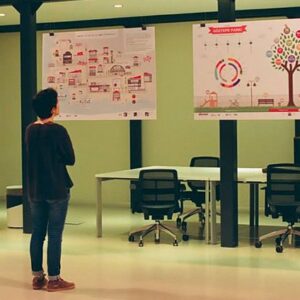Creativity Across Cultures
Creativity across cultures is increasingly important in the 21st century. U.S. employers rate creativity as one of the top five skills that will increase in importance during the next five years. The specific role of culture in creativity is still largely unstudied, but education — both the formal and informal sectors — is a relatively untapped resource to foster creativity across cultures.
(I recently presented a webinar, “Creativity Across Cultures” for edWeb.net. Please take a look at it and listen to some of the discussions among global educators who participated in the webinar.)
Do cultural factors nurture or limit creativity? Before answering that question, it is essential to define creativity.
Creativity is the capacity to produce novel, original and appropriate work. It is the ability to produce a new whole out of existing elements by arranging them into a new configuration.
“Big C” creators make a mark on the world in a domain that lasts beyond their lifetimes. Think Einstein.
“Little c” creators make life more interesting through inquisitiveness, imagination, and openness to new experiences. Think 21st century teaching and learning.
Creativity is crucial to solving our global challenges by developing new products, services and systems. It is valued in the global workforce and advocated by educational policymakers in countries throughout the world.
Students should be resilient and resolute, have an entrepreneurial and creative spirit and be able to think independently. (K-12 Educational Outcomes, Singapore Ministry of Education)
Education must demonstrate how creative energy and inventiveness have constantly improved the context and quality of human life. (Norwegian National Curriculum)
While there are numerous policy statements on the value of creativity in the educational system, schools throughout the world struggle to transform the traditional reward structure that values memorization more than independent thinking.
The major challenge facing formal educational systems throughout the world is moving from an emphasis on convergent thinking – getting the right answers to an emphasis on divergent thinking – struggling with problems, tolerating ambiguity.
Teachers can foster creativity in their classrooms by:
- Encouraging independent learning (this can be challenging in some Asian cultures)
- Practicing tolerance and openness to new ideas
- Motivating students to develop knowledge base for divergent thinking; ask – not answer – questions
- Delaying judgment and accepting ambiguity
- Promoting self-evaluation of ideas
- Helping students accept and cope with failure (this is often challenging in US and European cultures)
Project-based learning approaches across cultures and global curricula found in the International Baccalaureate diploma program are examples of teacher-facilitated creativity in the classroom.
But such approaches can be at odds with the dominant culture of standardized assessments. Research studies in both the United States and China, for example, have found that teachers generally favor quiet, conforming behaviors among their students, not the chaos and free-for-all environments encouraged in “creative classrooms.”

Informal educational settings offer opportunities for creative collaboration among students and teams
Informal education, that is, teaching and learning outside of school, offers an attractive alternative to the traditional classroom for “little c” creativity. Both teachers and students report they are comfortable exploring new ideas and experiences in the low-stakes environment of informal education. While educational policymakers throughout the world extol the value of the creative classroom, creativity in most classrooms still conform to the extrinsic motivation found in performance requirements and standardized assessments. Informal education offers opportunities for intrinsic motivation that frees students from concerns about evaluation that can sometimes kills creativity.
While some studies have shown generally increased creativity in “no reward” conditions, other studies conclude that boys are more creative in competitive situations than girls. The findings of these studies of classroom behavior have been replicated in the workplace. Men often thrive in extrinsic motivation environments where there is competition to be creative. Women, on the other hand, usually prefer conditions of intrinsic motivation where collegiality and collaboration are the preferred vehicles of creative problem solving.
A proclivity for creativity is a valued soft skill that researchers believe can be taught both inside and outside of school. Using imagination, being open to new experiences, and facing the fear of failure — components of “creative confidence” experienced by teachers and students outside of school may provide a pathway for creativity inside the classroom.














No Comments Yet!
You can be first to comment this post!